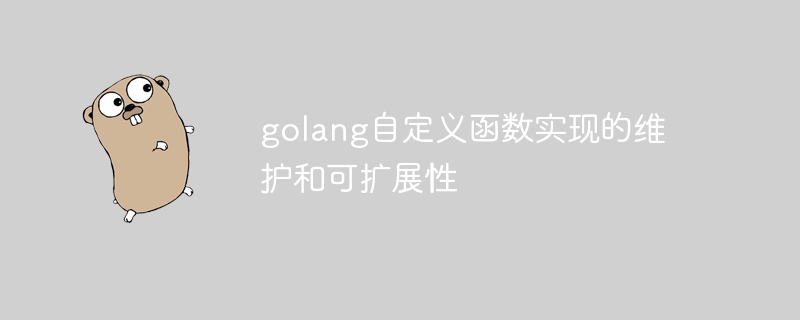Home >Backend Development >Golang >Maintenance and scalability of golang custom function implementation
Maintenance and scalability of golang custom function implementation
- WBOYOriginal
- 2024-04-26 18:54:01781browse
Answer: You can improve the maintainability and scalability of custom functions in Golang by following the steps: Naming convention: Use Hungarian nomenclature, with the prefix describing the function type or purpose. Interface: Define the mandatory behavior of the interface without implementation details, making it easy to replace the implementation. Avoid global variables: Use parameters or local variables to pass data to improve cohesion and loose coupling. Unit tests: Maintain confidence by writing tests to ensure functions work as expected. Practical case: Use interfaces and create implementations on demand to improve the maintainability and scalability of functions.

Maintenance and scalability of custom functions in Golang
Custom functions in Golang are used to improve code reusability and modular powerful tools. However, as your code base grows, maintaining and extending custom functions can become challenging. This article will discuss how to improve the maintenance and scalability of custom functions.
Follow Naming Conventions
Having a consistent naming convention helps identify functions across different files and packages in your project. It is recommended to use Hungarian nomenclature, where the prefix describes the type or purpose of the function. For example, you can name the function that gets user data GetUser(), and the function that writes data to a file named WriteToFile().
Use interfaces
Use interfaces to forcefully define the behavior of each function without the need for specific implementation details. This allows you to easily replace the implementation without changing the calling code. For example, you can define a UserGetter interface and create different implementations of it:
type UserGetter interface {
GetUser(id int) (*User, error)
}
// DatabaseUserGetter 获取存储在数据库中的用户。
type DatabaseUserGetter struct {...}
// MemoryUserGetter 获取存储在内存中的用户。
type MemoryUserGetter struct {...}Avoid using global variables
Global variables can make functions difficult to understand and testing. Instead, pass data to functions as arguments or use local variables. By avoiding global variables, you improve the cohesion and loose coupling of your code.
Using Tests
Writing unit tests is key to ensuring that functions work as expected and adhere to conventions and conventions. Testing helps identify problems when code changes and provides confidence that functions are maintained when code is modified.
Practical Case
Consider a custom function that calculates order discounts. Initially, the function is difficult to maintain and extend after using hardcoded values:
func CalculateDiscount() float64 {
return 5.0
}By using interfaces and creating implementations on demand, we can improve the maintainability and scalability of the function:
// Discounter 定义计算折扣的接口。
type Discounter interface {
CalculateDiscount() float64
}
// RegularDiscounter 提供固定折扣。
type RegularDiscounter struct {...}
// VIPDiscounter 提供更大的折扣给 VIP 客户。
type VIPDiscounter struct {...}
// 根据调用者的需求创建 Discounter 实现。
func GetDiscounter(ctx context.Context) Discounter {
userType := ctx.Value("user_type").(string)
switch userType {
case "regular":
return &RegularDiscounter{}
case "vip":
return &VIPDiscounter{}
default:
return nil
}
} In your application, you can calculate the discount by getting the appropriate Discounter implementation and calling the CalculateDiscount() method. This approach provides maintainability and extensibility because new discount strategies can be easily added by creating a new implementation and registering it in the GetDiscounter function.
The above is the detailed content of Maintenance and scalability of golang custom function implementation. For more information, please follow other related articles on the PHP Chinese website!

